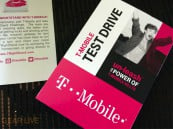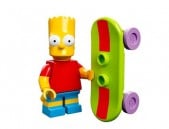Latest Gear Live Videos
Thursday January 7, 2010 1:40 pm
Q&A: James Childress & Conchy (1975)
 A million years ago, when I was but a small boy, my favorite comic strip was - and still is - Conchy by James Childress. The strip was about a group of beachcombers and it had the wackiness of early B.C. by Johnny Hart mixed with the philosophical melancholy of Charles Schulz’s Peanuts. And it was extremely well-drawn. I found out about Conchy in some obscure comic magazine, then realized it was not running in my local paper, The Roanoke Times & World News (because there had to be room for Dr. Smock, right?). But it did run in the Richmond Times-Dispatch. Being too broke to spend the money every day to get a copy of an out of town paper, I pulled a pre-Google and read it for free: by going to the local library every Sunday afternoon and reading a week’s worth of strips in one sitting.
A million years ago, when I was but a small boy, my favorite comic strip was - and still is - Conchy by James Childress. The strip was about a group of beachcombers and it had the wackiness of early B.C. by Johnny Hart mixed with the philosophical melancholy of Charles Schulz’s Peanuts. And it was extremely well-drawn. I found out about Conchy in some obscure comic magazine, then realized it was not running in my local paper, The Roanoke Times & World News (because there had to be room for Dr. Smock, right?). But it did run in the Richmond Times-Dispatch. Being too broke to spend the money every day to get a copy of an out of town paper, I pulled a pre-Google and read it for free: by going to the local library every Sunday afternoon and reading a week’s worth of strips in one sitting.
I loved it and I started to piece together a history of the strip and its creator. Childress himself was syndicating the strip on his own - no big syndicate to support and promote him. I remember being impressed by that gutsy DIY attitude; I had no idea such a thing was even possible. He worked his way up as an independent and subsequently got Conchy picked up by the same folks that syndicated Walt Kelly’s Pogo, Publishers-Hall.
 I got it in my head that I wanted to interview him and thought that I’d eventually put together an article for one of the cartoonist magazines like Cartoonist Profiles. So I jotted down a list of questions and sent them off to him in care of the Charlotte News because I found out somehow that’s where he held down a day job as their staff artist. Very quickly, he sent back a small package with the answers and a piece of original art - a Conchy daily strip. I needed an inhaler, and I didn’t have asthma.
I got it in my head that I wanted to interview him and thought that I’d eventually put together an article for one of the cartoonist magazines like Cartoonist Profiles. So I jotted down a list of questions and sent them off to him in care of the Charlotte News because I found out somehow that’s where he held down a day job as their staff artist. Very quickly, he sent back a small package with the answers and a piece of original art - a Conchy daily strip. I needed an inhaler, and I didn’t have asthma.
I never did get the smarts or the mad skillz to write the actual article and submit it, but I did self-publish the interview in my own little fanzine that maybe 25 friends of mine saw.
These questions were put together back in the summer of 1975 and reflect my youthful zeal and naivete - there were no follow up questions. I was grateful for the first set of answers and didn’t dare press my luck. Almost all of my questions reflect an interest in the business of cartooning, not the characters in the strip or its themes or its philosophical viewpoint. Make of that what you will.
Here’s my original introduction: Conchy, a comic strip revolving around a group of beachcombers, first came into being in 1960 and was rejected by the syndicates. Creator James Childress was moving around the country as a construction industry draftsman, also a talent self-taught in addition to his cartooning. Born in New York, he grew up in Tampa, and had fallen in love with North Carolina when stationed at Fort Bragg during his Army career with the paratroopers from age 17-20. It was after Childress got to Charlotte as a draftsman for Catalytic, Inc. that he was offered a job as the first staff cartoonist for the Charlotte News. After several years of self-syndication, Conchy was picked up by the prestigious Publishers-Hall syndicate and already has 157 daily and Sunday clients. For his staff work at the Charlotte News, Childress does 30 to 40 drawings a week. He illustrates the “Call Quest” action column every day on page one and does a Conchy sketch for the page one weather, a sketch for the “Personal Chat” second front column every day, illustrates Executive Editor Darrell Sifford’s column and does feature story illustrations.
TOM MASON: How did Conchy start?
JAMES CHILDRESS: I never had a working interest in art, commercial art or cartooning with the one single exception that I have wanted to do a comic strip from the time I was a boy. After trying for acceptance with the syndicates since 1960, I decided to self-syndicate Conchy. The promotion began in the summer of 1969 and I released the strip on March 2, 1970 in five newspapers. One paper, the Nashville Tennessean, has been with me since that beginning time.
Tom: How long does it take you to do a strip?
 James: The idea in a humor strip is the key ingredient. I place about 95% emphasis on that and about 5% on the drawing. In a story strip, the emphasis should receive equal attention. I have never really paid much attention to how long it takes to do a string in drawing but I suppose in a normal 8-hour day, three could be done at leisure, four with a bit more attention to the clock. Conchy, however, bears the cross of a part-timer: the strip is produced in the off-hours at home. The strip is lettered with a #1 Rapid-O-Graph pen, drawn with a Gillot #170 nib and the screen is Artype #4010. The paper is Strathmore, 2-ply, cold press Bristol board. I use a 5H or 6H lead with a drafting lead holder for the penciling. For the newspaper staff work, my methods vary. I will use mostly brush but will experiment with pen techniques and often draw with a blue pencil.
James: The idea in a humor strip is the key ingredient. I place about 95% emphasis on that and about 5% on the drawing. In a story strip, the emphasis should receive equal attention. I have never really paid much attention to how long it takes to do a string in drawing but I suppose in a normal 8-hour day, three could be done at leisure, four with a bit more attention to the clock. Conchy, however, bears the cross of a part-timer: the strip is produced in the off-hours at home. The strip is lettered with a #1 Rapid-O-Graph pen, drawn with a Gillot #170 nib and the screen is Artype #4010. The paper is Strathmore, 2-ply, cold press Bristol board. I use a 5H or 6H lead with a drafting lead holder for the penciling. For the newspaper staff work, my methods vary. I will use mostly brush but will experiment with pen techniques and often draw with a blue pencil.
Tom: How do you go about self-syndicating the strip?
James: I will select a newspaper, call the editor and tell him, briefly, about Conchy then ask him if he will take a look at my presentation. They will usually say yes. The phone call will have them in a frame of mind to be expecting the material, thus it will not be lost among the many items an editor receives daily. I will call back in a week and I will be told about the problems dealing with the budget, space, and other reasons as to why the strip cannot be added. You will never sell one right off, or at least I never did. My suggestion then would be to ask if they were interested in following the proofs and from here on it would be a series of follow-ups.
Tom: What are some of the problems of self-syndication?
James: The feeling of “if the strip is any good, why hasn’t a major syndicate already accepted it?”; an addition to the billing department for a “syndicate” which will never carry a billing for more than a single feature; cry-baby independents who will hound an editor to no end if they cancel his feature; the history that independents will give up because none (to my knowledge) have ever gotten out of the red or reached the point of even making a little money; the instability in general of an independent. There are other things I’m sure, but these are the major problems.
Tom: What were some of the reasons that Publishers-Hall picked up the strip in 1974, instead of when the strip began in 1970?
 James: There is not a syndicate executive in the business that will tell you there is any formula to picking a winner. Publishers-Hall - at this point - felt that Conchy had become a marketable product. Some of the influencing factors came about - I am sure - because of the national publication of my paperback (Conchy On The Half-Shell) via Grosset & Dunlap (1973), the strip’s record of not being cancelled very often, the doubling of my client list during the newsprint shortage and the results of a Carl Nelson Survey that placed Conchy in the top 15 strips nationally. In short, there was something about the strip now that was marketable. Before that, all the syndicates and the overwhelmingly vast majority of newspaper editors felt the humor was too subtle for the masses. As things look at the moment, Conchy is working. But - with a note of cautiousness - tomorrow has yet to dawn. We will see what will happen. Publishers-Hall - in my mind - is the finest of the syndicates. I feel very fortunate to be a member of their organization.
James: There is not a syndicate executive in the business that will tell you there is any formula to picking a winner. Publishers-Hall - at this point - felt that Conchy had become a marketable product. Some of the influencing factors came about - I am sure - because of the national publication of my paperback (Conchy On The Half-Shell) via Grosset & Dunlap (1973), the strip’s record of not being cancelled very often, the doubling of my client list during the newsprint shortage and the results of a Carl Nelson Survey that placed Conchy in the top 15 strips nationally. In short, there was something about the strip now that was marketable. Before that, all the syndicates and the overwhelmingly vast majority of newspaper editors felt the humor was too subtle for the masses. As things look at the moment, Conchy is working. But - with a note of cautiousness - tomorrow has yet to dawn. We will see what will happen. Publishers-Hall - in my mind - is the finest of the syndicates. I feel very fortunate to be a member of their organization.
Tom: How many papers carried the strip before Publishers-Hall picked it up?
James: 26. The Richmond Times-Dispatch (which carried the strip for two years earlier) and the St. Louis Globe-Democrat represented my final sales.
Tom: How far ahead of schedule to you work?
James: Three weeks when I was an independent, now four weeks. The Sunday page is further ahead…I don’t remember what it is right now. I will have to check with the syndicate again. I forgot.
Tom: How large are your originals?
James: One is enclosed.
(Note: And it was too! It measures 10 3/4 x 2 7/8 inches, still framed and hanging in my office.)
Tom: How have your paperbacks been selling?
James: The publisher is pleased with the response. Most likely a reissue of Conchy On The Half-Shell will appear as the strip receives more exposure through Publishers-Hall.
Tom: Every cartoonist is asked this same question, so this occasion will be no exception. What cartoonist do you admire most?
James: Charles M. Schulz is the greatest comic strip creator that has ever been or will be. I have really thought long and hard on that and that answer is my conviction.
The relationship between Childress and Publishers-Hall eventually soured as the syndicate tried to change the strip’s humor to a more traditional gag-a-day approach. Childress severed the relationship and went back to self-syndicating Conchy. Because of problems in his personal life, he took his own life in January 1977. He was 35 years old. This interview was conducted through the mail in the fall of 1975.
Interview © Tom K. Mason
[Artwork: A Conchy daily strip, © James Childress]
For more on Childress and some sample artwork, check out his brief listing at Lambiek.
Don Markstein has a nice entry for him at Toonpedia.
Over at Planet Peschel, Bill Peschel posted a heartfelt multi-part essay on Childress and Conchy several years ago. Still very much worth reading and it also includes some Conchy sample strips.
And you can find my previous post on Conchy right here.
Advertisement
Advertisement
Advertisement
© Gear Live Media, LLC. 2007 – User-posted content, unless source is quoted, is licensed under a Creative Commons Public Domain License. Gear Live graphics, logos, designs, page headers, button icons, videos, articles, blogs, forums, scripts and other service names are the trademarks of Gear Live Inc.












Comments: